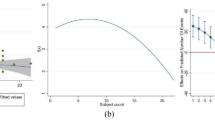Abstract
Measuring the intellectual diversity encoded in publication records as a proxy to the degree of interdisciplinarity has recently received considerable attention in the science mapping community. The present paper draws upon the use of the Stirling index as a diversity measure applied to a network model (customized science map) of research profiles, proposed by several authors. A modified version of the index is used and compared with the previous versions on a sample data set in order to rank top Hungarian research organizations (HROs) according to their research performance diversity. Results, unexpected in several respects, show that the modified index is a candidate for measuring the degree of polarization of a research profile. The study also points towards a possible typology of publication portfolios that instantiate different types of diversity.



Similar content being viewed by others
References
Csardi, G., & Nepusz, T. (2006). The igraph software package for complex network research. InterJournal Complex Systems, 1695.
Korenius, T., Laurikkala, J., & Juhola, M. (2007). On principal component analysis, cosine and Euclidean measures in information retrieval. Information Sciences, 177(22), 4893–4905.
Leydesdorff, L., & Rafols, I. (2009). A global map of science based on the ISI subject categories. Journal of the American Society for Information Science and Technology, 60(2), 348–362.
Leydesdorff, L., & Rafols, I. (2010). Indicators of the Interdisciplinarity of Journals: Diversity, Centrality, and Citations. Arxiv preprint arXiv:1003.3613.
Porter, A., Cohen, A., Roessner, D., & Perreault, M. (2007). Measuring researcher interdisciplinarity. Scientometrics, 72(1), 117–147.
Porter, A., & Rafols, I. (2009). Is science becoming more interdisciplinary? Measuring and mapping six research fields over time. Scientometrics, 81(3), 719–745.
Porter, A., & Youtie, J. (2009). How interdisciplinary is nanotechnology? Journal of Nanoparticle Research, 11(5), 1023–1041.
R & D Core Team (2009). R: A language and environment for statistical computing. Vienna: R Foundation for Statistical Computing. ISBN 3-900051-07-0, URL http://www.R-project.org.
Rafols, I.; Porter, A., & Leydesdorff, L. (2009). Science overlay maps: a new tool for research policy and library management. Arxiv preprint arXiv:0912.3882.
Rafols, I., & Meyer, M. (2007). How cross-disciplinary is bionanotechnology? Explorations in the specialty of molecular motors. Scientometrics, 70(3), 633–650.
Rafols, I., & Meyer, M. (2010). Diversity and network coherence as indicators of interdisciplinarity: Case studies in bionanoscience. Scientometrics, 82(2), 263–287.
Stirling, A. (2007). A general framework for analysing diversity in science, technology and society. Journal of the Royal Society Interface, 40(15), 707.
Acknowledgment
We acknowledge the financial support from the Future and Emerging Technologies (FET) programme within the Seventh Framework Programme for Research of the European Commission, under the FET- Open grant number 233847 (Dynanets project, www.dynanets.org).
Author information
Authors and Affiliations
Corresponding author
Appendix
Appendix
Conceptual relations of the distance measures of the proposed and the popular versions of the Stirling index
The relation between the proposed distance measure, the weighted path length \( g_{ij}^{W} \), and the popular distance measure, the cosine distance is illustrated by Fig. 5. On the graph, a configuration of SCs characteristic of the basemap is depicted: SCJ can be reached from SCI in two steps, and vice versa, as these are connected by SCK. The dotted line stands for an edge that is either nonexistent or omitted, bearing a weight below the chosen minimum of similarity values. On the lines edge weights are indicated.
In this case, the two calculations would provide the following results.
-
(1)
Cosine distance Applying the cosine distance as the distance parameter means using directly the edge weights in the Stirling index. In the case shown below, the distance between SC I and SC J is
$$ { \cos }\left({\mathbf{SC}}_{I} ,{{\mathbf{SC}}_{J} } \right) = {\mathbf{d}}_{IJ} $$ -
(2)
Weighted path length By our definition, the distance between SC I and SC J is the weighted (shortest) path length, which, assuming that the direct link between the two is omitted, yields
$$ g^{W} \left( {{\mathbf{SC}}_{I} ,{\mathbf{SC}}_{J} } \right) = {\mathbf{d}}_{KI} + {\mathbf{d}}_{KJ}. $$
Since the direct link connecting the two SCs is missing, the cosine similarity between them is zero (or set to zero by imposing the threshold), by which the cosine distance (1–cosine similarity) equals to 1. The sum of the other two weights could be either above, or below this value, since the cosine distance does not obey to the rule of triangle inequality (Korenius et al. 2007), by which fact
does not hold, therefore
For the diversity measure, these considerations have the consequence that using the weighted path length measure can make the diversity index much more sensible to the relatedness of Subject Categories in that it approximates otherwise uniformly treated distances (missing links) by different values. Theoretically, this also holds for the case where no threshold is used, and the calculation depends on the full weight matrix of the network, which means placing back some links to the system. Set aside the remaining set of missing links (the representing SCs not related at all), the path length values might also differ from cosine similarity values for below-threshold connected SCs as well, mirroring a different kind of connection between them.
Rights and permissions
About this article
Cite this article
Soós, S., Kampis, G. Towards a typology of research performance diversity: the case of top Hungarian players. Scientometrics 87, 357–371 (2011). https://doi.org/10.1007/s11192-011-0351-8
Received:
Published:
Issue Date:
DOI: https://doi.org/10.1007/s11192-011-0351-8






